Santorini Travel Guide
Introduction
Santorini Travel Guide – Santorini (or Thíra), the precious gem of the Aegean Greece, is actually a group of islands consisting of Thíra, Thirassiá, Asproníssi, Palea and Nea Kaméni in the southernmost part of Cyclades. The whole complex of Santorini islands is still an active volcano (the same as Méthana, Mílos and Nísiros) and probably the only volcano in the world whose crater is in the sea? The islands that form Santorini came into existence as a result of intensive volcanic activity; twelve huge eruptions occurred, one every 20,000 years approximately, and each violent eruption caused the collapse of the volcano’s central part creating a large crater (caldera). The volcano, however, managed to recreate itself over and over again.
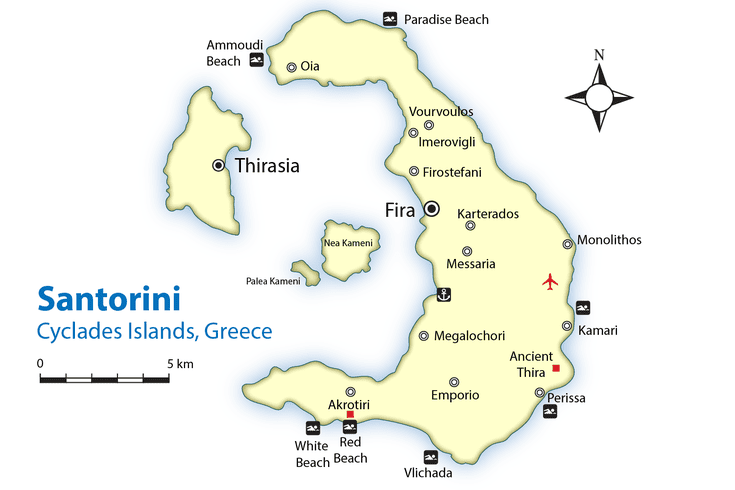
The last big eruption occurred 3,600 years ago (during the Minoan Age), when igneous material (mainly ash, pumice and lava stones) covered the three islands (Thíra, Thirassiá and Asproníssi). The eruption destroyed the thriving local prehistoric civilization, evidence of which was found during the excavations of a settlement at Akrotíri. The solid material and gases emerging from the volcano’s interior created a huge “vacuum” underneath, causing the collapse of the central part and the creation of an enormous “pot” –today’s Caldera– with a size of 8×4 km and a depth of up to 400m below sea level. The eruption of the submarine volcano Kolúmbo, located 6.5 km. NE of Santorini, on 27th September 1650, was actually the largest recorded in Eastern Mediterranean during the past millennium! The most recent volcanic activity on the island occurred in 1950. The whole island is actually a huge natural geological/volcanological museum where you can observe a wide range of geological structures and forms!
One of the best destination for honeymoon
Santorini is considered to be the most sought after place for a romantic getaway in Greece, since there are not many places in the world where you can enjoy exquisitely clear waters while perched on the rim of a massive active volcano in the middle of the sea! The island has a growing reputation as a “wedding destination” for couples not only from Greece but from all over the world. A trip to Santorini with the other half is a dream for anyone who has seen at least one photo of the island’s famous Caldera and exchanging kisses beneath Santorini’s famous sunset is the ultimate romantic experience! Read more for Santorini honeymoon
Let’s Explore the island
Firá is the picturesque capital of the island; perched high up on the edge of the Caldera, it looks like a marvellous painting. Firá, together with Oia, Imerovígli and Firostefáni located high above on a cliff, make up the so-called “Caldera’s eyebrow”, the balcony of Santorini, which offers an amazing view of the volcano. Other famous smaller villages are Akrotíri and Méssa Vounó, with their famous archaeological sites, Pýrgos, Karterádes, Emporió, Ammoúdi, Finikiá, Períssa, Perívolos, Megalohóri, Kamári, Messariá and Monólithos: some of the villages are cosmopolitan some more peaceful; they are surrounded by vast vineyards; whitewashed cliff-top towns with castles affording amazing views out over the Aegean. Soaking up the villages’ distinctive traditional atmosphere is a very rewarding experience.
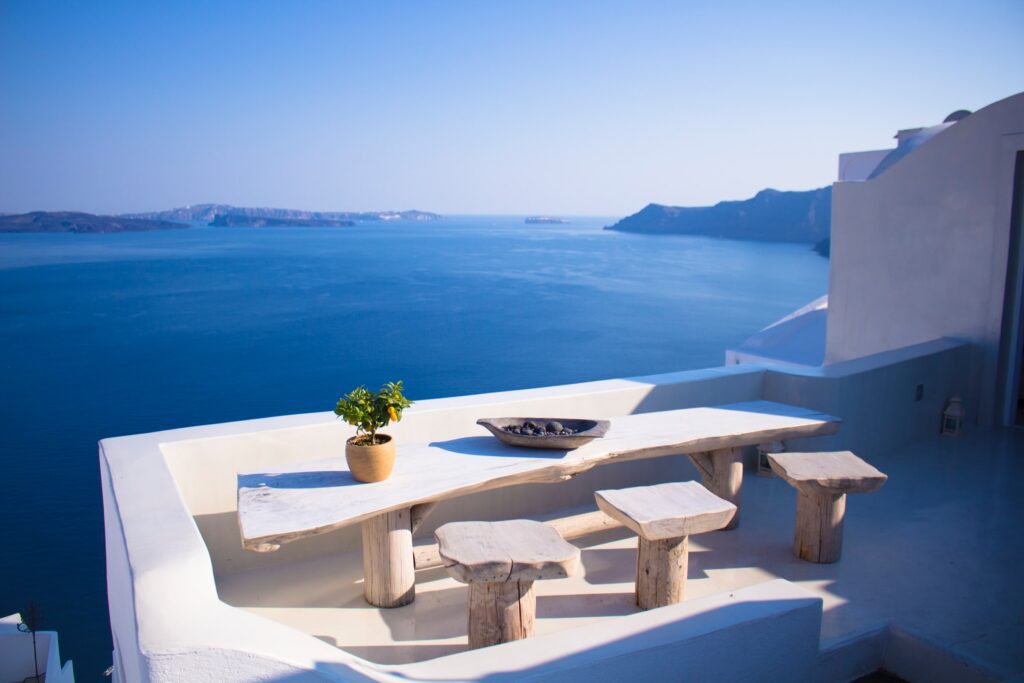
Gastronomy
A visit to Santorini is the ultimate gastronomic experience, as the island is a true culinary paradise! Treat your taste buds to some famous traditional products like cherry tomatoes, white egg plants, fava, caper and “hloró tyrí”, a special kind of fresh goat cheese found on the island, or why not try some of the exceptional wines produced from grapes grown in the volcanic soil of the island! Assyrtiko, Athyri, Aidani, Mantilaria and Mavrotragano are just some of the distinctive varieties that you can taste at the island’s famous wineries (some of them operate as a museum as well) or at restaurants. Related: Santorini Wines

Volcanic soil and the Aegean breeze: Santorini’s ingredients
Did you know that a visit to Santorini would still be a unique experience even if the island wasn’t as breathtakingly beautiful as it is? Did you know that visitors here enjoy a feast not just for their eyes but also for their taste buds? The dazzling light and the Aegean breeze combined with the island’s fertile volcanic soil nurture the local agricultural products, endowing them with top quality and a unique taste. The most renowned products from Santorini are:
Fava (fava beans)
Used in many recipes, ranging from freshly boiled plain fava to fava with pork or with tomato puree, or as a soup, with rice or in an omelette, these peas are popular with visitors to Santorini thanks to their fine taste.
White aubergines
The magic thing about this variety of aubergine is not just that it has been coloured white by the volcanic soil. It is also that the bitterness sometimes found in aubergines is completely absent and instead the flesh is sweet and juicy.
Capers
Both the flowers and the leaves are used in local cuisine for their spicy sharp aroma.
Cherry tomatoes
It was in the 18th century that the locals first cultivated this variety of tomatoes, which owe their unique taste to the arid soil of the island.
Beaches
Venture into Santorini’s seaside treasures and enjoy deep blue waters and beaches with white, red or black sand or volcanic pebbles, spectacular rock formations and impressive lunar landscapes. Santorini, the youngest volcanic land in the Eastern Mediterranean, is waiting for you! You can reach it by plane or by ship from Piraeus. Don’t think twice! Experience for yourself the once-in-a-lifetime romance and charm of this pearl of the Aegean.

Start your journey in the northern part of the island at the sun-drenched beaches around Oia; they have a wild untamed beauty and most of them cannot easily be spotted from the main road. Ammoudi, on the harbour of Oia, is a picturesque beach lined with charming cafes and restaurants. The small beach of Armeni with its azure waters and magnificent view of the island of Thirassia can either be reached by boat from Ammoúdi or on foot. There is a small footpath connecting Oia with Armeni, but if you find it hard to climb up and down 286 steps, riding a donkey is the alternative solution! A diving centre is also available for adventure-seeking beachgoers. Looking for a little seclusion and serenity? Baxedes (or Paradisos), a quiet beach with black sand and chiselled rocks or the black-grey sandy beach of Kolumbo (mostly frequented by nudists) are the ideal choice…According to volcanologists, the largest active underwater crater of Santorini is located in Kolumbo! Katharοs beach will impress you with its wild landscape whereas Pori is a quiet family beach!
The wild beauty of the beaches on the eastern side of the island will prove irresistible to sunseekers looking for peace and seclusion since they are neither organised nor much frequented. Impressive sculptured rocks, black sand, volcanic pebbles, small ports with fishing boats casting colourful reflections on azure waters and a few beech trees are the trademarks of Xiropigado, Vourvoulos and Exo Gialos.
On the south-eastern side of Santorini, sun-loving tourists will encounter magnificent black sandy or pebbly beaches. Monolithos is strongly recommended for families, as the water is very swallow compared to other Santorini beaches and there are facilities, like playgrounds, to keep the children entertained. Young people can have fun in a beach bar or at a beach volley playground. Soak up the atmosphere along the lively waterfront at one of the charming beach bars or bask in the turquoise blue waters of the cosmopolitan beach of Kamari, one of the island’s most crowded and organised beaches! Amongst Santorini’s most sought after beaches, especially among young people, are Perissa, Perivolos and Agios Georgios, which actually stretch out one after another to create the longest black sandy beach on the island; bustling beach bars, diving and water sport centres (including jet ski, parasailing, wind surfing and canoe-kayak) and beautiful-people-watching! Could you ask for more?

Let’s go south, where the (semi-organised) beach of Vlychada with its grey sand, its huge rock formations sculpted over the years by the wind and its unique lunar landscape awaits us! Recently a large modern marina which is home to the Sailing and Yacht Club of Santorini has been constructed here. Nearby lies the beach of Almyra, where sun worshippers can enjoy a beautiful quiet beach with impressive sea-sculpted rocks in the background. The Akrotiri area is famous for its ruins of an ancient town but tan-seeking sunbathers will also discover some marvellous beaches there. Caldera is a small and very quiet beach with black sand and deep crystal clear waters which enjoys an unrivalled view of the volcano, while Gialos is a secluded beach accessible only by jeep.
Close to the excavation site of Akrotiri you will find what is probably the most famous beach on the island, the Red Beach! What makes the beach absolutely irresistible is its impressive red rock formations, which form a breathtaking unique volcanic landscape. Access involves a walk from the harbour of Akrotiri (around 10 minutes) or by boat from Kamari, Akrotiri and Perissa, but the all-red landscape is certainly worth the trek! The nearby White Beach is another stunning seascape that you simply must not miss! Black sand, big grey and white pebbles and gigantic white rocks form a bizarre setting like you’ve never seen before.
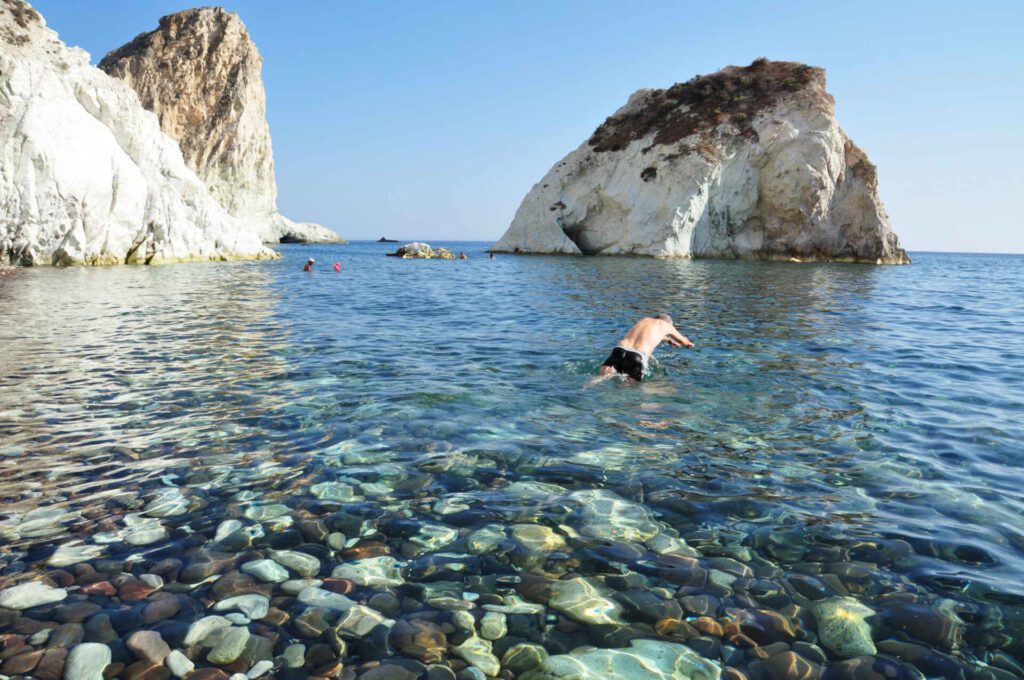
While you are on Santorini you can also take part in an exciting sea excursion departing from the old port of Firá or from Athinios port, depending on which trip you choose. Visit the two small islands at the centre of Caldera, Palea and Nea Kameni, the “volcano” according to the locals, or combine your excursion with a visit to Thirassia and Oia. And of course…could you think of anything more romantic than watching the famous Santorini sunset onboard?
Last but not least, some tips for action lovers:
• Best spots for scuba diving: cape of Tripiti at Thirassia, Palia Kameni (the shipwreck), Mesa Pigadia, Ammoudi, Armenis (wall dive), Aspronissi
• Diving centres are located at: Ammoudi, Kamari, Perissa and Oia
• Windsurfing/jet ski equipment at the following beaches: Kamari, Perissa, Avis
Santorini in the winter
Like most of southern Europe, Santorini enjoys a Mediterranean climate with hot summers and mild winters. The off-season lasts from late October until mid-April (Greek Easter) and is characterised by average temperatures between 10°C and 15°C. January and February are the coldest and rainiest months. Thermometers can drop under 5°C/41F, and winds tend to be sharp. Snowfall is a rare event though.

If you hate summer-hot weather but don’t want to freeze either, the best months to visit Santorini in the off-season are November and March. Nights are still cold during these months, but daytime temperatures often exceed 15°C. More sun and less rain also make these months perfect for hiking and sightseeing.
What to do during winter in Santorini?
Discover Prehistoric Akrotiri
Winter isn’t the season to sunbathe and swim in Santorini, but it certainly is the right one for discovering the island’s rich history. And where better to get started than the prehistoric site of Akrotiri?
Believed to be the home of legendary Atlantis, this prehistoric settlement was abandoned by its inhabitants due to a powerful earthquake then buried by mud and volcanic ashes during the famous eruption of Santorini’s volcano in 1627 BC. Protected by layers of magma, the settlement has been preserved almost intact over the centuries and resurfaced in the 1960s when the Greek archaeologists discovered it. Here, you can admire astonishing frescoes that still maintain their original bright colours as well as a variety of artefacts, including pottery, weapons, and domestic items. The archaeological site is perfectly connected with Fira even in winter and easily accessible by public transport.
Visit Akrotiri Lighthouse
After learning more about Santorini’s history at the archaeological site, don’t miss a stop at Akrotiri lighthouse. This is the southernmost tip of the island, opposite Oia, and the perfect place for soaking in the stunning views of the dramatic coastline.
Climb to Skaros Rock
A protruding rocky headland and the medieval capital of Santorini, Skaros Rock is another unmissable landmark to see during your stay. Like most medieval settlements, it originally had defensive purposes, a function that explains its location atop a cliff overlooking the rest of the island.The medieval town used to be densely populated, but the people gradually moved to Fira due to earthquakes.Today, you can admire the remains of this once flourishing settlement and discover the Chapel of Panagia Theoskepasti, a hidden worship place that is impossible to spot from the mainland.
Explore Imerovigli
A stone’s throw from Skaros Rock, Imerovigli is the island’s most elevated town and one of the best places to explore in Santorini in winter. Without hordes of tourists crowding its alleys and stairwells, you can get lost in the maze of narrow paths and admire the characteristic architecture and slow pace of local life. Along the way, admire the superb coastal views and stop in one of the few tavernas or restaurants that stay open during the low season if you want to have a taste of authentic Santorini food.
Watch the Sunset in Oia (and Visit the Atlantis Bookshop)
When you think of Greece, you see whitewashed houses with bright blue roofs, and when you think of these dwellings, you most likely think of Oia. Featured on the covers of most travel magazines and advertised in many online and print publications, Oia is Santorini’s precious jewel. A stroll among these picture-perfect buildings is, therefore, a must. And so is watching one of the most spectacular sunsets from one of the panoramic viewpoints scattered throughout the town. Indeed, the sunset in Oia is more than a sunset. It is a magical event capable of captivating even the toughest souls. Besides the surreal beauty enhanced by the lack of crowds, this is also the perfect place for snapping the perfect shot to post on social media. And after you’ve recovered from the trance, don’t forget to look for Atlantis Books, a one-of-a-kind bookshop rich in history and boasting precious treasures trapped in the quirky books that populate its old shelves.
Stroll Along Perissa Beach
Santorini – like any other Greek island, as a matter of fact – is synonymous with expanses of sand, crystalline waters, sunbathing, and seaside holidays. Sure, swimming or even sunbathing don’t top the lists of things to do in Santorini during the cold season, but you can still discover the beauty of its beaches.
Of all Santorini’s beaches, the best to check out in winter is Perissa, a dark expanse of volcanic sands flanked by peculiar cliffs on one side. The landscape here looks so otherworldly in winter that for a moment, you might even forget where you are.
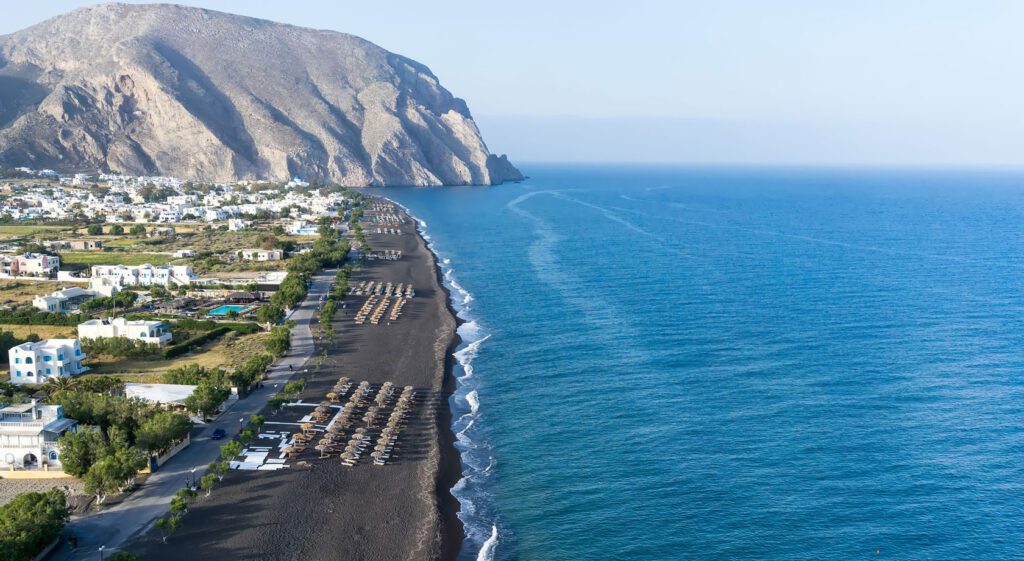
Alongside the beach, the nearby Perissa village is also worth your attention. Most shops and restaurants are closed in winter, but you can still visit the whitewashed Timiou Stavro church, a traditional building topped by distinctive blue domes.
Hike the Caldera Trail
Stretching from Fira to Oia, the Caldera hiking trail is the main draw for many tourists who decide to book a winter trip to Santorini. More than a hike, this is a true adventure that gives you the opportunity to discover some of the island’s most picturesque sites. The hike is about 10 kilometres long and is supposed to take around two and a half hours to complete. It isn’t particularly challenging and is your best bet if you want to admire as much as you can of the island’s iconic views. No doubt, you’ll have a hard time putting the camera down the entire way.
Take a Winery Tour
Greece is not as famous as its Mediterranean peers like Italy, Spain, and Portugal when it comes to wine, but it can still impress oenophiles with the godly nectar produced in Santorini. Indeed, the island is famous for its fantastic wines.
What makes them unique is the special terroir resulted from the perfect combination of the island’s volcanic soil and mild weather all year round.
Archaeological evidence shows that wines have been produced in the region for thousands of years, so a tour of the island’s wineries is a must. This will give you the opportunity to taste the Mavrotragano and Voudomato wines, two robust red varieties particularly suitable for winter.
Other noteworthy local wines include the vintage Nychteri, traditionally produced only after sunset, as well as Athiri, Aidani, and Assyrtiko, three of the most popular white wines.
Those with a sweet tooth should also try Santorini’s Vinsanto, a sweet dessert wine made from the raisins of grapes left to dry in the sun. Connoisseurs will particularly enjoy the differences between Santorini’s Vinsanto and the wine of the same name produced in Tuscany.
Discover Emporio and Pyrgos
Oia might be Santorini’s most popular destination, but not the only one worth visiting. Emporio and Pyrgos are two beautiful villages that beg to be explored.
Emporio is officially the biggest village on the island, built in the traditional “castle settlement” style. All houses are built next to each other in a circle, and there is only one way in and out. It goes without saying that this architectural style served defensive purposes, but it is still amazing to see.
While most buildings here sport the characteristic whitewashed facades, the village also boasts a Venetian tower and a few windmills. Furthermore, the Byzantine ruins just outside the settlement attract those with an interest in archaeology.
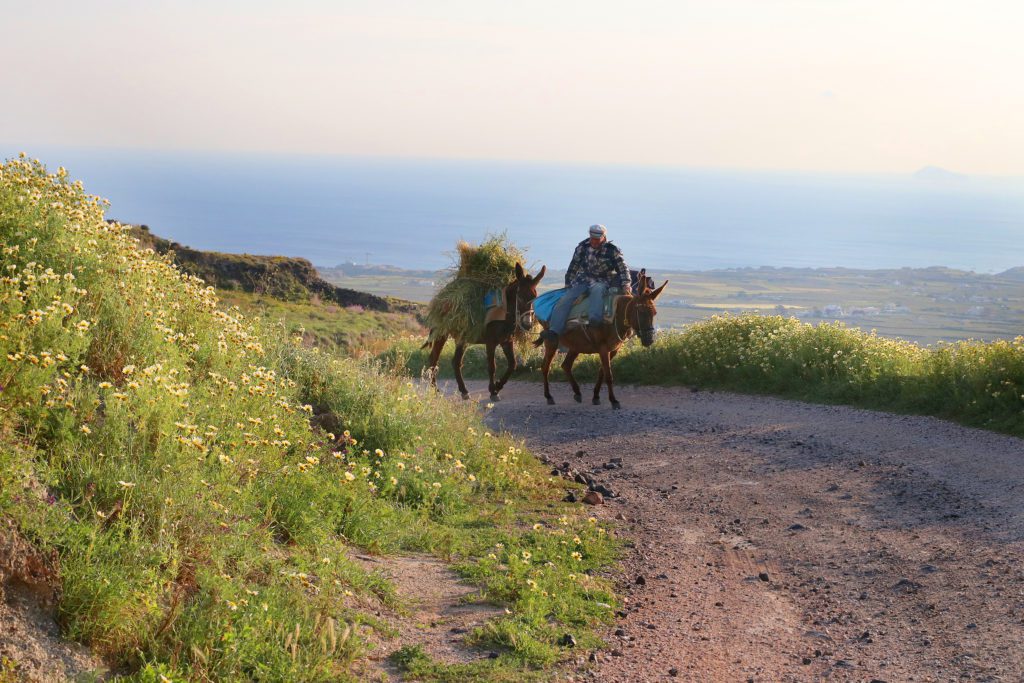
Situated about 7 kilometres from Fira, Pyrgos is the highest village in Santorini. Its architectural style was originally similar to Emporio, but many of the dwellings here were destroyed by an earthquake in the twentieth century before being demolished.
Like many of the old houses in Santorini, the remaining dwellings in Pyrgos are built partly underground. Strolling along the cobbled laneways and up the representative steep steps will give you the opportunity to admire them in all their splendour.
The ruins of Pyrgos castle overlook the entire island from the highest point of the village and give you the perfect spot for observing the slow, quaint rhythms of Santorini in the cold season.
Indulge in Local Delicacies
In winter, most of Santorini closes down, including some hotels and touristy restaurants. And this only means one thing; the restaurants that stay open are local favourites, the places where you can taste Santorini’s authentic cuisine.
Among the many delicious dishes to taste during your stay, don’t miss the Greek moussaka made from ground meat, potatoes, and other vegetables. The roasted Greek lamb and fava me koukia should also be on your list. Gyros is a popular street food you should also give a try if you like meat, or go for the tomato gefthedes if you’d like a vegan alternative.

Restaurants apart, don’t hesitate to enter one of the many bakeries that stay open throughout the winter. Besides delicious desserts, here you can also taste traditional cheese pies and other savory pastries that will make you fall in love with Santorini’s culinary scene.
Best time to visit Santorini
Santorini is an island destination so it’s best to go when the weather is ideal. It’s warmest with the least amount of rain from April till November. However, July and August are peak months on the island making it the busiest and most expensive time to visit.
For that reason, you may want to go from late April till June or September till early November. These are the shoulder seasons in Santorini. The weather is great and it doesn’t get as crowded nor as hot as July and August.
We went in mid-April. The weather was pleasant with alternating sunny days and overcast skies, though it still got chilly at night and early in the morning. There were many tourists in Fira and Oia but not enough to make it unpleasant.
APR-JUNE: There are fewer people The weather from late April till June is nice and there aren’t as many tourists yet.
JULY-AUG: This is peak season in Santorini. July and August are the hottest months of the year so it’s the best time to lay on the beach and go swimming. However, it’s also the most crowded with hotel prices at their peak.
SEPT-NOV: Like late April till June, this is shoulder season in Santorini. The weather is pleasant and the crowds thinner than in July or August.
Climate


Related Reading
- Santorini Less Than 48 Hours
- What to Photograph in Greece
- Island Hopping in Greece
- Perfect Honeymoon in Santorini
Book a tour for Santorini
- Santorini short break | 3 Days
- Athens – Naxos – Santorini – Crete | 14 Days
- Athens – Mykonos – Santorini | 10 Days
- Athens – Milos – Folegandros – Santorini | 11 Days
- Romantica – Honeymoon in Greece | 13 Days
- Best of Turkey and Greece with 6-day Island Hopping
- Best of Turkey and Greece with a 3 days Cruise
- Best of Turkey and Greece with 2 days cruise










